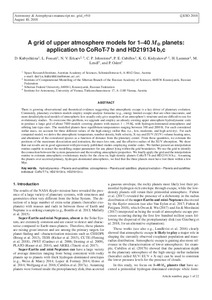Показать сокращенную информацию
Grid of upper atmosphere models for 1-40 M⊕ planets: application to CoRoT-7 b and HD 219134 b,c
| Автор | Kubyshkina, D. | |
| Автор | Fossati, L. | |
| Автор | Erkaev, N. V. | |
| Автор | Johnstone, C. P. | |
| Автор | Cubillos P. E. La | |
| Автор | Kislyakova, K. G. | |
| Автор | Lammer, H. | |
| Автор | Lendl, M. | |
| Автор | Odert, P. | |
| Дата внесения | 2020-01-20T08:04:27Z | |
| Дата, когда ресурс стал доступен | 2020-01-20T08:04:27Z | |
| Дата публикации | 2018-11 | |
| Библиографическое описание | Kubyshkina, D. Grid of upper atmosphere models for 1-40 M⊕ planets: application to CoRoT-7 b and HD 219134 b,c [Текст] / D. Kubyshkina, L. Fossati, N. V. Erkaev, C. P. Johnstone, Cubillos P. E. La, K. G. Kislyakova, H. Lammer, M. Lendl, P. Odert // ASTRONOMY & ASTROPHYSICS. — 2018. — Т. 619. | |
| ISSN | 14320746 | |
| URI (для ссылок/цитирований) | https://www.aanda.org/articles/aa/abs/2018/11/aa33737-18/aa33737-18.html | |
| URI (для ссылок/цитирований) | https://elib.sfu-kras.ru/handle/2311/129818 | |
| Аннотация | There is growing observational and theoretical evidence suggesting that atmospheric escape is a key driver of planetary evolution. Commonly, planetary evolution models employ simple analytic formulae (e.g. energy limited escape) that are often inaccurate, and more detailed physical models of atmospheric loss usually only give snapshots of an atmosphere's structure and are difficult to use for evolutionary studies. To overcome this problem, we have upgraded and employed an existing upper atmosphere hydrodynamic code to produce a large grid of about 7000 models covering planets with masses 1-39 M⊕ with hydrogen-dominated atmospheres and orbiting late-type stars. The modelled planets have equilibrium temperatures ranging between 300 and 2000 K. For each considered stellar mass, we account for three different values of the high-energy stellar flux (i.e. low, moderate, and high activity). For each computed model, we derived the atmospheric temperature, number density, bulk velocity, X-ray and EUV (XUV) volume heating rates, and abundance of the considered species as a function of distance from the planetary centre. From these quantities, we estimate the positions of the maximum dissociation and ionisation, the mass-loss rate, and the effective radius of the XUV absorption. We show that our results are in good agreement with previously published studies employing similar codes. We further present an interpolation routine capable to extract the modelling output parameters for any planet lying within the grid boundaries. We used the grid to identify the connection between the system parameters and the resulting atmospheric properties. We finally applied the grid and the interpolation routine to estimate atmospheric evolutionary tracks for the close-in, high-density planets CoRoT-7 b and HD 219134 b,c. Assuming that the planets ever accreted primary, hydrogen-dominated atmospheres, we find that the three planets must have lost them within a few Myr. | |
| Тема | planets and satellites | |
| Тема | atmospheres | |
| Тема | dynamical evolution and stability | |
| Тема | CoRot-7 b | |
| Тема | HD 219134 b | |
| Тема | HD 219134 c | |
| Название | Grid of upper atmosphere models for 1-40 M⊕ planets: application to CoRoT-7 b and HD 219134 b,c | |
| Тип | Journal Article | |
| Тип | Journal Article Postprint | |
| ГРНТИ | 41.23.21 | |
| Дата обновления | 2020-01-20T08:04:27Z | |
| DOI | 10.1051/0004-6361/201833737 | |
| Институт | Политехнический институт | |
| Подразделение | Кафедра прикладной механики | |
| Журнал | ASTRONOMY & ASTROPHYSICS | |
| Квартиль журнала в Scopus | Q1 | |
| Квартиль журнала в Web of Science | Q1 |

